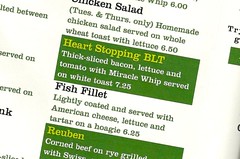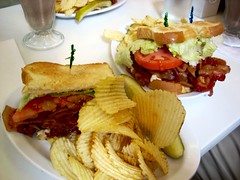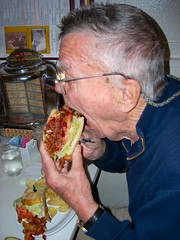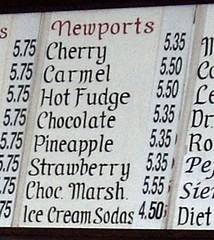At some point in our lives (usually by the age of 6), we have to admit to ourselves that Santa Claus, the Easter Bunny and the Tooth Fairy aren’t real. This revelation is both depressing and liberating, germinating the seeds of skepticism and logic that govern our lives as adults. Rational debate is one of the distinguishing hallmarks of adulthood.
For reasons I cannot understand, movies involving vampires, werewolves and zombies remain immensely popular, despite the simple logical arguments that render them into implausible childish myths. All of these creatures are proposed as physical beings, not supernatural or magical. And yet, all but one of them could exist without the aid of some unspecified force that is not part of the natural world.
Vampires, for example, must consume human blood to live. What is the component of human blood that enables them to survive that is not present in rabbit blood or cow blood? It’s never explained, because there is no such component. Animal blood would be much easier to obtain, and reduce vampires from a terrifying threat to ordinary neighbors who have an unusual diet and work the night shift.
And does anyone really believe that vampires can be repelled by crucifixes or garlic? Or that they can transform themselves into bats or other creatures? (See werewolves, below.)
The one thing I can believe about vampires is that they have a sensitivity to light. Not the blistering, screaming, bursting-into-flames sensitivity that we see in the movies, just the kind of thing that could be handled by 30 SPF sunblock, a floppy hat and a pair of Oakleys.
Werewolves are supposedly human beings who have contracted a disease from another infected human. Every 28 days, for no apparent reason, the human is forced to change into a wolf for one night, which makes no sense at all. Becoming a wolf does not serve any purpose. I like to imagine the werewolf virus mutating every year, like the flu. One year, you’re a panda. Next year, you’re an armadillo.
The thing I find laughable about werewolves is that nobody bothers to calculate the metabolic cost of transforming from a human form to that of a wolf (and back again) in the space of a few minutes. You couldn’t consume enough calories in a lunar month to accomplish it, and the stress of the transformation would undoubtedly kill you.
The problem with zombies is that there are two kinds (depending on your literary source) - a reanimated corpse or a living human infected with some germ or toxin. Regardless of the zombie definition, both of them want to kill non-zombie humans. They are universally depicted as profoundly retarded creatures, so how do they tell a zombie from a non-zombie? And why humans? What’s the appeal? Why not pigeons or cats?
The idea of a rotten corpse somehow developing the ability to move and produce enough energy to dig itself out of a grave and walk around is just absurd. The degraded tissues would be incapable of such actions, not to mention the indignities imposed on corpses by morticians. I suppose an argument could be made that fresh corpses are available everywhere, but I think the living would outnumber them by a large margin, so they wouldn’t pose very much of a threat.
That leaves the “infected living” zombie. It’s easy to imagine a human being turned into a psychopathic killer, because psychopaths already exist. Of the three, it’s the only one that has no logical barriers. So far, nobody has developed an infectious agent that will accomplish this goal. The only thing we know for sure is that somewhere, deep in an underground lab, somebody is working on it.
So I’m not sharpening stakes or making silver bullets, but maybe a shotgun wouldn’t be such a bad idea.
Wednesday, March 30, 2011
Saturday, March 5, 2011
XD28NE
The problem with mental illness is that typically you don’t know you have it until someone else tells you, or until you diagnose yourself. Most people are unwilling to diagnose themselves. However, recently I’ve begun to feel as though I might suffer from a form of Obsessive-Compulsive Disorder (OCD).
I don’t wash my hands a dozen times a day or eat my food counter-clockwise or lock the door repeatedly. I read automobiles.
For example, I read vanity plates, often maneuvering in traffic to get a better look. Because of the character limit, some of them can be cryptic puzzles. “NGOTI8R,” for example, or “RCKTMN.” Others are simple, such as the two I saw in one day a few months ago: “HUGEEGO” and “FREUD.” How funny would it be if they were involved in a collision?
I know this doesn’t seem like much of an obsession, but if I can’t figure one out, it bothers me all day. But that’s just a small part of the problem. What really consumes me are bumper stickers and decals.
Most are textual, so they’re not especially hard to figure out. Others are in the form of symbols or images that don’t make immediate sense. I try to group them into categories. The top two categories are Decorative and Affiliations. The Decorative category holds those items that are displayed solely for their aesthetic value.
The Affiliations category holds those items that indicate the preferences or formal memberships held by the driver. They fall into sub-categories: Religious, Military, Professional, Sports, Ethnic, Political and Entertainment. Usually, I can pick the category from a distance, and identify the exact affiliation when I get a little closer. Entertainment is the hardest, because unknown bands often have unintelligible names or strange logos.
On my daily commute, I often see the same vehicles, which have become familiar to me. There’s the lady with the “Never, Never, NEVER Shake a Baby!” bumper sticker. And the guy with a dozen stickers: 11 espousing extremist political opinions and one that says “Coexist.”
But there’s one car I see all the time, that bears this indescribable image, along with the message, “XD28NE:”

The image resembles a scarab beetle, or perhaps a radiation warning sign. I thought it might be an image from a video game, or a band logo – but a Google search of “XD28NE” reveals nothing.
The unsolvable mystery of this image is driving me insane. Please, if you have any idea what this represents, let me know. I’ll be eternally grateful, and far less likely to run this person off the road to demand the answer.
I don’t wash my hands a dozen times a day or eat my food counter-clockwise or lock the door repeatedly. I read automobiles.
For example, I read vanity plates, often maneuvering in traffic to get a better look. Because of the character limit, some of them can be cryptic puzzles. “NGOTI8R,” for example, or “RCKTMN.” Others are simple, such as the two I saw in one day a few months ago: “HUGEEGO” and “FREUD.” How funny would it be if they were involved in a collision?
I know this doesn’t seem like much of an obsession, but if I can’t figure one out, it bothers me all day. But that’s just a small part of the problem. What really consumes me are bumper stickers and decals.
Most are textual, so they’re not especially hard to figure out. Others are in the form of symbols or images that don’t make immediate sense. I try to group them into categories. The top two categories are Decorative and Affiliations. The Decorative category holds those items that are displayed solely for their aesthetic value.
The Affiliations category holds those items that indicate the preferences or formal memberships held by the driver. They fall into sub-categories: Religious, Military, Professional, Sports, Ethnic, Political and Entertainment. Usually, I can pick the category from a distance, and identify the exact affiliation when I get a little closer. Entertainment is the hardest, because unknown bands often have unintelligible names or strange logos.
On my daily commute, I often see the same vehicles, which have become familiar to me. There’s the lady with the “Never, Never, NEVER Shake a Baby!” bumper sticker. And the guy with a dozen stickers: 11 espousing extremist political opinions and one that says “Coexist.”
But there’s one car I see all the time, that bears this indescribable image, along with the message, “XD28NE:”

The image resembles a scarab beetle, or perhaps a radiation warning sign. I thought it might be an image from a video game, or a band logo – but a Google search of “XD28NE” reveals nothing.
The unsolvable mystery of this image is driving me insane. Please, if you have any idea what this represents, let me know. I’ll be eternally grateful, and far less likely to run this person off the road to demand the answer.
Tuesday, March 1, 2011
The Mysterious Newport
I grew up in St. Louis, Missouri and left immediately after completing college there. Back in those days (40 years ago), St. Louis was a classic example of urban blight. People fled to the suburbs, and the inner city deteriorated into a dangerous mixture of empty, decaying buildings, and poor, desperate people. I couldn’t wait to get out.
During the time I lived there, the Gateway Arch was constructed, Sportsmen’s Park was replaced by the “technologically advanced” Busch Stadium (which itself has been replaced recently), and the notorious Pruitt-Igoe housing project was built, only to be demolished 16 years later after becoming a rat-infested slum.
All of these construction projects had one thing in common: Acres of shabby, condemned buildings were bulldozed to make room for them. But it wasn’t just urban renewal that scoured entire neighborhoods from the St. Louis landscape. Gaslight Square, the well-known nightclub district vanished during my college years, a victim of crime and neglect.
It’s hard for me to believe that anything remotely historic survives in St. Louis. On my visit there last week, my sister took me to the Crown Candy Kitchen. This place opened in 1913, but despite the fact that I grew up in St. Louis, I had never heard of it.
It’s a tiny remnant of a genteel time. Part restaurant, part soda fountain, part confectionary, you can easily imagine clean-cut teenagers hanging out and playing the jukebox during the 1950’s. Today it survives in a formerly-depressed neighborhood that desperately wants to gentrify, but can’t quite get over the hump. The Crown Candy Kitchen has become something of a hipster lunchtime destination. My sister took me there because she wanted me to try the Heart Stopping BLT.

This sandwich differs from a normal BLT in that proportionally, the lettuce and tomato contribute almost nothing to the taste. Nearly a pound of bacon is crammed between two slices of white bread.

My sister and I split one, but my 88-year old father never met a meal he couldn’t finish.

The Crown Candy Kitchen is a charming old building, with hand-made booths, a pressed-tin ceiling, and hand-lettered signs. The menu over the soda fountain listed prices for Sundes, Special Sundaes, Deluxe Sundaes, and something called “Newports.” A waitress explained to us that a Newport is a normal sundae, but it’s topped with whipped cream and crushed pecans.

I’m fascinated that I’ve never heard of a Newport before. If this is a regional delicacy, you’d think I would know about it, having grown up in the region. I know about frappes and jimmies in Massachusetts, scrapple in Pennsylvania, and prairie oysters in Nebraska. Maybe the Crown Candy Kitchen is like the last of a dying species, the only place left that retains once-common cultural knowledge.
During the time I lived there, the Gateway Arch was constructed, Sportsmen’s Park was replaced by the “technologically advanced” Busch Stadium (which itself has been replaced recently), and the notorious Pruitt-Igoe housing project was built, only to be demolished 16 years later after becoming a rat-infested slum.
All of these construction projects had one thing in common: Acres of shabby, condemned buildings were bulldozed to make room for them. But it wasn’t just urban renewal that scoured entire neighborhoods from the St. Louis landscape. Gaslight Square, the well-known nightclub district vanished during my college years, a victim of crime and neglect.
It’s hard for me to believe that anything remotely historic survives in St. Louis. On my visit there last week, my sister took me to the Crown Candy Kitchen. This place opened in 1913, but despite the fact that I grew up in St. Louis, I had never heard of it.
It’s a tiny remnant of a genteel time. Part restaurant, part soda fountain, part confectionary, you can easily imagine clean-cut teenagers hanging out and playing the jukebox during the 1950’s. Today it survives in a formerly-depressed neighborhood that desperately wants to gentrify, but can’t quite get over the hump. The Crown Candy Kitchen has become something of a hipster lunchtime destination. My sister took me there because she wanted me to try the Heart Stopping BLT.

This sandwich differs from a normal BLT in that proportionally, the lettuce and tomato contribute almost nothing to the taste. Nearly a pound of bacon is crammed between two slices of white bread.

My sister and I split one, but my 88-year old father never met a meal he couldn’t finish.

The Crown Candy Kitchen is a charming old building, with hand-made booths, a pressed-tin ceiling, and hand-lettered signs. The menu over the soda fountain listed prices for Sundes, Special Sundaes, Deluxe Sundaes, and something called “Newports.” A waitress explained to us that a Newport is a normal sundae, but it’s topped with whipped cream and crushed pecans.

I’m fascinated that I’ve never heard of a Newport before. If this is a regional delicacy, you’d think I would know about it, having grown up in the region. I know about frappes and jimmies in Massachusetts, scrapple in Pennsylvania, and prairie oysters in Nebraska. Maybe the Crown Candy Kitchen is like the last of a dying species, the only place left that retains once-common cultural knowledge.
Subscribe to:
Posts (Atom)
